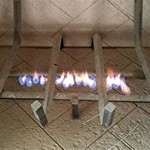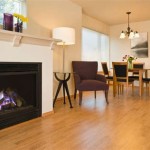Styles of Gas Fireplaces: A Comprehensive Overview
Gas fireplaces offer a compelling alternative to traditional wood-burning fireplaces, providing the ambiance and warmth of a fire without the associated mess and complexities of wood sourcing and storage. The versatility of gas as a fuel source allows for a diverse range of fireplace styles, catering to various aesthetic preferences and functional requirements. This article explores the different styles of gas fireplaces, providing a comprehensive overview of their features and applications.
### Direct Vent Fireplaces: Efficiency and SafetyDirect vent fireplaces are characterized by their sealed combustion system, which draws air for combustion from outside the home and vents exhaust gases directly outdoors. This design eliminates the need for a traditional chimney and significantly enhances energy efficiency. The sealed system prevents the depletion of indoor air and minimizes the risk of backdrafting, contributing to a safer indoor environment. Direct vent fireplaces are particularly well-suited for modern homes that prioritize energy efficiency and air quality.
The installation of a direct vent fireplace is relatively straightforward, as it requires only a vent pipe that can be routed through an exterior wall or roof. This flexibility allows for installation in various locations within a home, including spaces without existing chimneys. The viewing area of direct vent fireplaces is typically enclosed behind a glass panel, which maintains the integrity of the sealed combustion system and prevents accidental contact with the flames.
Direct vent fireplaces are available in a wide array of styles, ranging from traditional log sets to contemporary linear designs. The flame appearance can be customized through various burner options, allowing homeowners to achieve their desired aesthetic. Furthermore, many direct vent fireplaces offer features such as remote controls, programmable thermostats, and variable flame height adjustments, enhancing user convenience and control.
### Vent-Free Fireplaces: Simplicity and FlexibilityVent-free fireplaces, also known as ventless fireplaces, operate without the need for venting to the outside. They utilize a special oxygen depletion sensor (ODS) that monitors the oxygen levels in the room and automatically shuts off the gas supply if levels become dangerously low. This feature is designed to prevent carbon monoxide poisoning, a potential hazard associated with incomplete combustion.
The primary advantage of vent-free fireplaces is their ease of installation and flexibility in placement. Since they do not require venting, they can be installed in virtually any room of the house, provided that the room meets certain minimum size requirements to ensure adequate ventilation. Vent-free fireplaces are often a popular choice for supplemental heating in bedrooms, basements, and other areas where additional warmth is desired.
However, it is crucial to understand the limitations and safety considerations associated with vent-free fireplaces. While the ODS system provides a safety mechanism, it is essential to ensure proper ventilation in the room where the fireplace is installed. It is also important to use the fireplace according to the manufacturer's instructions and to regularly inspect and maintain the unit to ensure its safe and efficient operation. Some jurisdictions have restrictions or prohibitions on the use of vent-free fireplaces, so it is essential to check local building codes before installing one.
The aesthetic options for vent-free fireplaces are diverse, ranging from traditional log sets to more modern designs. However, the flame appearance may differ slightly from that of vented fireplaces, as the combustion process is optimized for efficiency rather than purely aesthetic appeal. The heat output of vent-free fireplaces can be substantial, making them effective for heating smaller spaces.
### B-Vent Fireplaces: Traditional Chimney IntegrationB-vent fireplaces, also known as natural vent fireplaces, rely on a traditional chimney to vent exhaust gases. These fireplaces utilize a single-wall vent pipe (B-vent) to expel the products of combustion through the chimney. Unlike direct vent fireplaces, B-vent fireplaces draw combustion air from within the room, which can slightly reduce energy efficiency.
B-vent fireplaces are often chosen for their resemblance to traditional wood-burning fireplaces, offering a more authentic aesthetic. They typically feature realistic log sets and a robust flame appearance. B-vent fireplaces are well-suited for homes that already have a traditional chimney in place, as they can utilize the existing infrastructure. However, the chimney must be properly inspected and maintained to ensure safe and efficient operation.
The installation of a B-vent fireplace involves connecting the unit to the existing chimney using a B-vent pipe. It is crucial to ensure that the vent pipe is properly sized and installed to prevent backdrafting and carbon monoxide poisoning. Regular chimney cleaning and inspection are also essential to maintain the safety and performance of the fireplace.
B-vent fireplaces are available in a variety of sizes and styles, ranging from small units suitable for bedrooms to larger models designed for living rooms and family rooms. They offer a balance between aesthetic appeal and heating performance, making them a popular choice for homeowners who value the traditional look and feel of a fireplace.
Beyond these primary categories, other gas fireplace styles include insert fireplaces which are designed to fit into existing wood-burning fireplace openings, and linear fireplaces often seen in contemporary designs. Each style offers a unique combination of aesthetics, efficiency, and installation requirements, enabling homeowners to select the gas fireplace that best aligns with their individual needs and preferences. Careful consideration should be given to local building codes, safety regulations, and professional installation to ensure that the chosen gas fireplace provides years of safe and reliable heating.

The Types Of Gas Fireplaces Gaithersburg Md Fireplace Service
.aspx?strip=all)
Types Of Gas Fireplaces Styles Venting Explained Regency

Diffe Types Of Fireplaces Compared Full Service Chimney

Gas Fireplaces Chimney Sweep

4 Types Of Gas Fireplace Venting Options G B Energy

12 Types Of Gas Fireplaces You Need To Know

2024 Gas Fireplace Trends Design Regency

How To Modernize And Update A Gas Fireplace We Love Fire

12 Types Of Gas Fireplaces You Need To Know

Direct Vent Gas Fireplaces The Ultimate Guide Learning Center








